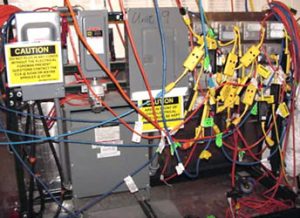
Not the proper use of GFCIs
Although most portable electric tools have an equipment- grounding conductor and many are double insulated, these methods are not fool proof. A grounding wire could break, or a cord could become defective. Using a GFCI overcomes these insulation problems.
A ground fault occurs when the electrical current does not complete its circuit and unintentionally flows to the ground. Ground faults can cause fires and are dangerous when they flow through a person to the ground.
Where GFCIs Are Needed:
GFCIs are required to provide approved ground-fault circuit interrupters for all 120-volt, single phase, 15-and 20- ampere receptacle outlets being used on construction sites that are not a part of the permanent wiring of the building or structure. Since extension cords are not part of the permanent wiring, a GFCI device must protect any electrical tools or equipment plugged into extension cords.
Insulation around flexible extension cord conductors can be damaged through hard usage or excessive wear. If the “hot” wire conductor of the extension cord were to come into contact with the grounding wire conductor, a ground fault would occur.
GFCIs should certainly be used in wet environments. When a cord connector is wet, hazardous current leakage can occur to the grounding conductor and to anyone who picks up that connector if they also provide a path to ground.
PROTECT YOURSELF FROM ELECTRIC SHOCK…USE SAFETY EQUIPMENT!!
Download flyer: STOTW_715_Electrical Safety Using GFCIs Download Spanish flyer: STOTW_715_Electrical Safety Using GFCIs_esp

